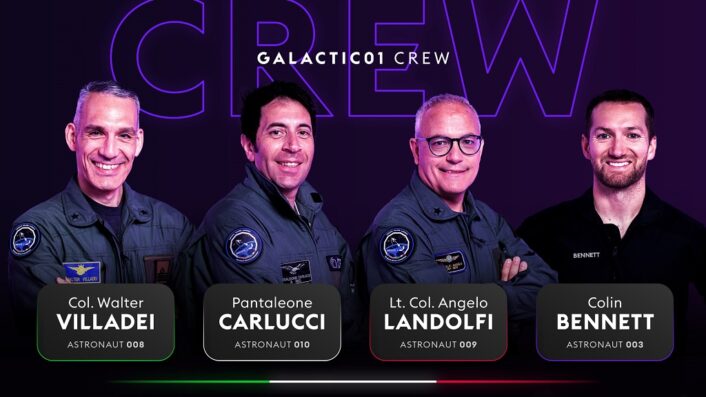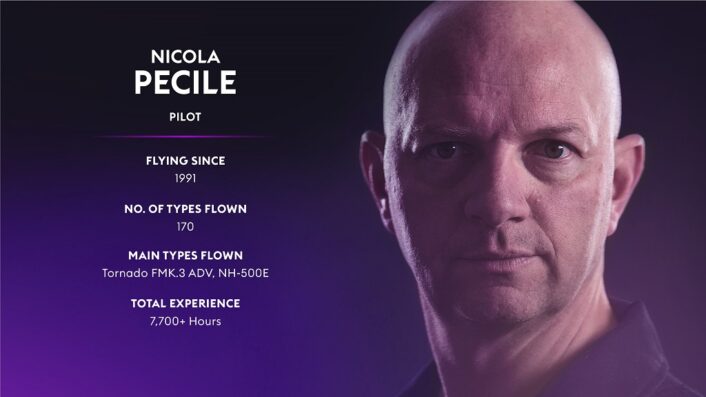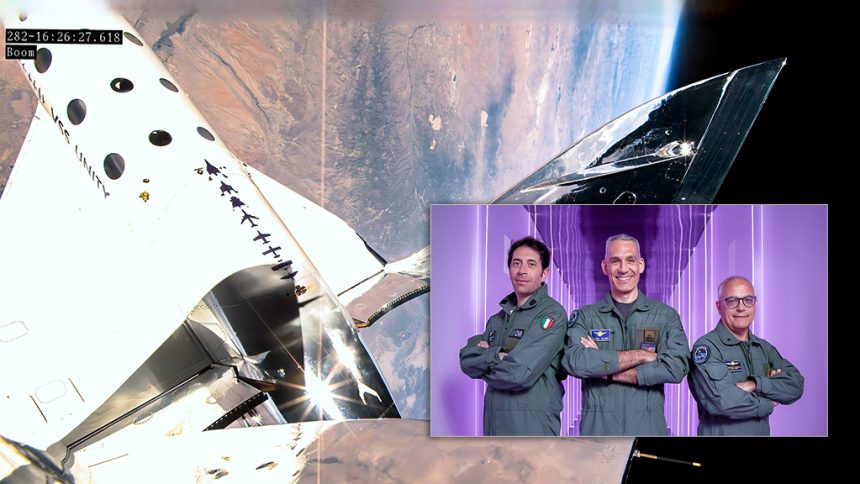The team aboard VSS Unity will work on 13 science payloads during a 90-minute suborbital flight.
A joint team of the Italian Air Force and the National Research Council will launch on the first commercial spaceflight of Virgin Galactic, “Galactic 01” on June 29, 2023. VSS Unity’s cabin will be transformed into a suborbital science lab to provide the environment for rack mounted payloads and for the crew to interact with wearable payloads. The joint mission has been called VIRTUTE (Volo Italiano per la Ricerca e la Tecnologia sUborbiTalE – Italian Flight for Suborbital Research and Technology).
“VIRTUTE 1 mission is the first Italian and European suborbital flight. A breakthrough and pathfinder mission, conceived and designed with Italian National Research Council and Virgin Galactic to test the versatility of suborbital spaceflight for scientific and technological research,” said Colonel Walter Villadei, the mission commander. “We are flying payloads from multiple disciplines in one mission and are utilizing the entire flight profile to collect invaluable data. Suborbital spaceflight will revolutionize aeronautics transportation in the future, expanding access to space for a much larger community, and advance the development of scientific research.”
The flight is part of an agreement signed by the Italian Air Force and Virgin Galactic in 2019, which was supposed to see an Italian crew fly on the “Unity 2023” mission in 2021. However, shortly after announcing the collaboration with the National Research Council in early 2021, the mission was postponed VSS Unity was undergoing a programmed vehicle enhancement and modification period.
After the completion of the “Unity 25” spaceflight and subsequent routine analysis and vehicle inspections, the last of three test flights after the modifications, the company is ready to start monthly spaceflights from its Spaceport America in New Mexico. With the “Galactic 01” mission, Virgin Galactic says it will double the amount of research payloads flown on its vehicles and demonstrate the ability to use suborbital spaceflights to train astronauts for future orbital missions.
“’Galactic 01’ is our first commercial spaceflight, and we’re honored to have been selected by the Italian Air Force and the National Research Council to support their first space research mission, ‘Virtute 1’,” said Michael Colglazier, CEO of Virgin Galactic. “Virgin Galactic’s research missions will usher in a new era of repeatable and reliable access to space for government and research institutions for years to come.”
The mission will be used to conduct 13 human-tended and autonomous experiments which examine biomedicine thermo-fluid dynamics, and the development of innovative and sustainable materials in microgravity conditions. The research team will also collect data through wearable payloads and sensors, and by autonomous payloads mounted in the cabin on Virgin Galactic’s payload rack system.

Research activities
Here is a quick breakdown of the experiments that will be performed on VSS Unity:
- Doosy-CNR-VG and 2. Liulin-CNR-VG: The Doosy and Liulin payloads are testing equipment that will measure cosmic radiation in the mesosphere (50-100 km), where limited data has previously been collected. This mission will collect data from two different types of devices, passive dosimeters and a spectrometer radiometer.
- droP Impact iN micro-Gravity (PING): This autonomous rack-mounted payload will expel droplets from nozzles onto different materials with tuned micro-structured surfaces, to understand how drops come in contact and stick to different materials in microgravity.
- Italian Combustion Experiment – Suborbital Flight (ICE – SF): This experiment studies the combustion characteristics of renewable liquid biofuels and the behavior of complex fluids at high temperature. The autonomous payload will have three distinct experimental apparatuses operating simultaneously, each designed to perform a specific experiment on biofuel droplets.
- TetRafluoroethAne sPonge (TRAP): This highly-innovative evaporator will transform liquid into a gaseous phase, similar to how fluid transfer is done in an air conditioner, but in a microgravity environment. This new technology could be applied in cold gas propulsion systems for microsatellites.
- Cabin Air Quality (CAQ): This autonomous payload will use a small nanoparticle monitor to measure the indoor air quality of suborbital flights to apply to future long duration missions. Specifically, the payload will evaluate the sources and levels of any ultrafine particles that are present.
- SHApe Recovery of Composite Structures (SUNRISE-VG01-SHARCS): This human-tended rack-mounted payload consists of the deployment of a small composite boom made of a shape memory polymer composite (SMPC). The experiment, which can only be performed in microgravity, will observe how quickly the boom will recover its original shape once heated up.
- TESting in Space (SUNRISE-VG02-TESIS): This experiment studies the effect of microgravity on liquid mixing with different mixtures. Of particular interest is the production of foams from materials with very different densities, as these foams are very difficult to produce on Earth.
- Scientific-Health Area Experiments: These biology experiments in orbit are aimed at improving performance and physical efficiency of future astronauts for space missions, including space motion sickness. This autonomous payload is rack-mounted and connected to accelerometers under the researchers’ seat, studying vibrations in spaceflight vehicles and their link to motion sickness in people flying to suborbital space.
- Smart Flight Suit 1 (SFS1): This is a technology demonstrator of a new class of flight suits for space activities. The flight suit consists of innovative equipment designed with ergonomic criteria to provide comfort with breathable and fireproof-class fabrics that can withstand over 6 G of acceleration and includes a t-shirt with an integrated device to collect biomedical data from the researcher during each phase of flight.
- ECG Holter Monitoring: An electrocardiogram (ECG) Holter monitor will record 12 signals from the researcher during the suborbital spaceflight, assessing cardiac responses to acceleration. The data will be used to evaluate the cardiovascular effort exerted during the spaceflight.
- Passenger’s Comfortability: To study cognitive conditions during spaceflight, one of the Italian crew members will perform working memory exercises during flight with devices measuring the body’s response. The researcher will use a tablet to perform tests on mental workload and sustained attention, an electroencephalogram (EEG) cap to measure brain activity and a sensor on the hand to measure the galvanic skin’s response.
- Pre and post flight ground activities: These activities are divided in three primary parts, evaluating the linkage among oxidative stress, circadian rhythms and neuroplasticity during exposure to a microgravity environment, the potential effects of suborbital flight on the human organism and the impact to endothelial tissue function as a result of suborbital flight.

The crew members
The crew is composed by people from different areas of expertise, each assigned to different experiments:
Col. Walter Villadei, the mission commander, is a professional astronaut qualified on SpaceX’s Crew Dragon, Soyuz, ISS systems, and Orlan for EVA activities. He was also the backup pilot for the recent Axiom Space Mission 2 on the ISS and, during Virtute 1, will be tending to the rack-mounted payloads and wearing a state-of-the-art smart suit to measure his biometric data and physiological responses.
Lt. Col. Angelo Landolfi, a highly specialized physician also trained as crew surgeon as part of Cosmonaut training program, will measure cognitive performance in microgravity and investigate how certain liquids and solids mix in microgravity.
Pantaleone Carlucci is an engineer and pilot working the the National Research Council. During Virtute 1 he will wear multiple sensors that examine heart rate, brain function and other human performance metrics during spaceflight and in microgravity.
Together with the three Italian crew members will be Colin Bennett, the lead astronaut instructor who carried out all training and preparation for the Italian mission.
On VSS Unity there will be also a fourth Italian member, Nicola Pecile, who will pilot Unity together with commander Mike Masucci. Pecile, at his first spaceflight, is a former Lieutenant Colonel and test pilot of the ItAf, which has been hired by Virgin Galactic in 2015 after working as director of operations for the National Test Pilot School in the Mojave Desert, where VMS Eve and VSS Unity were based before the move to Spaceport America.










